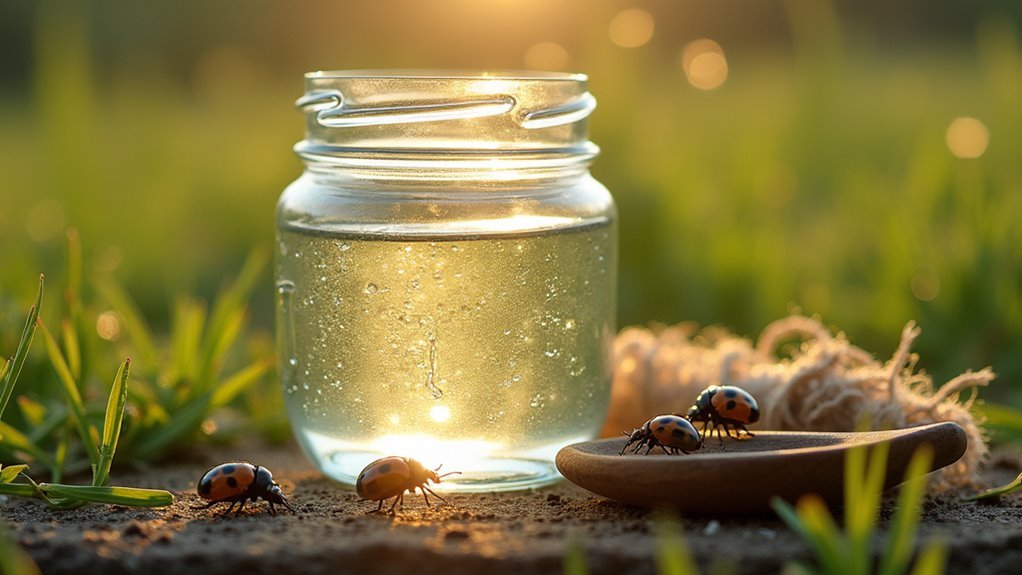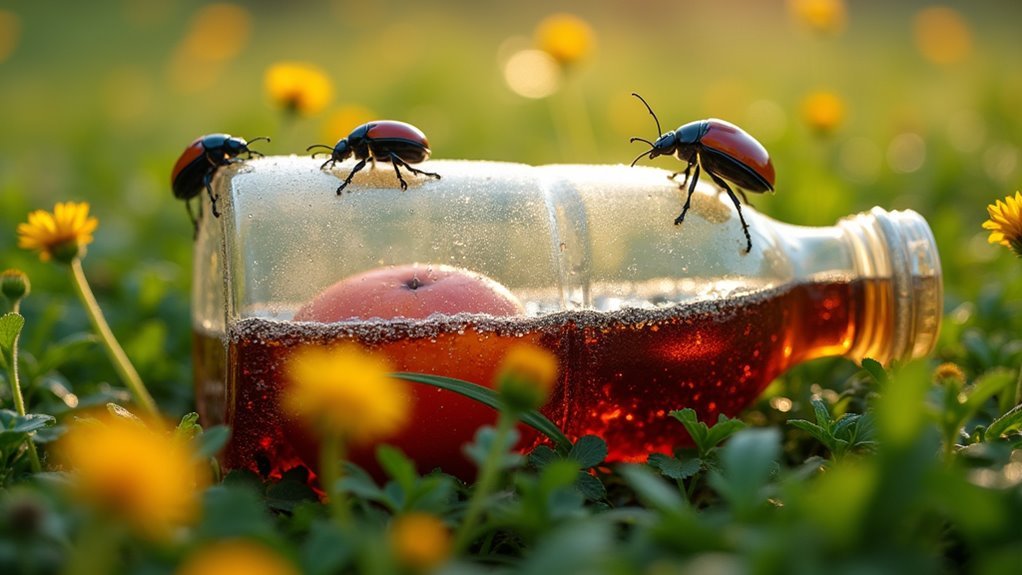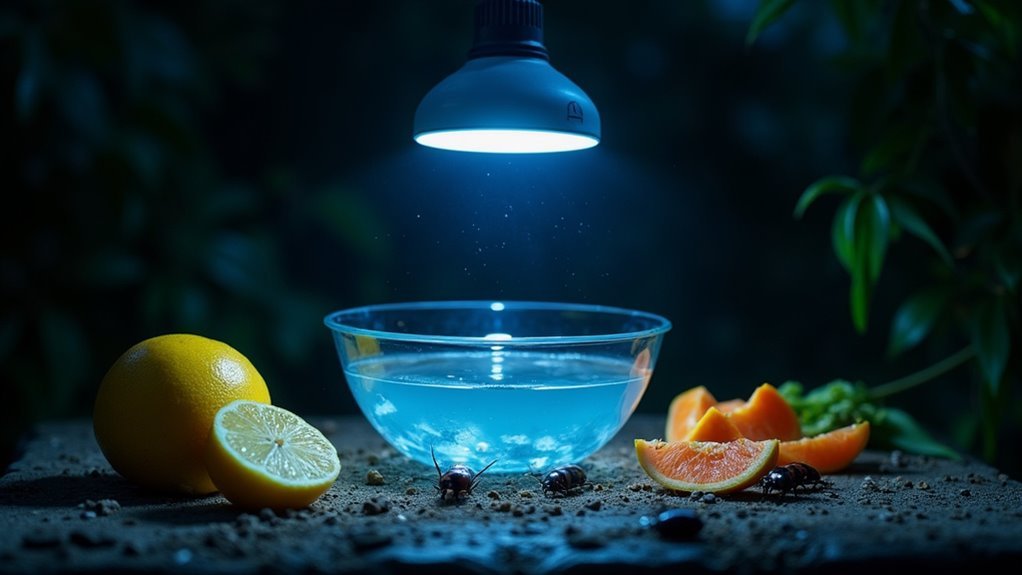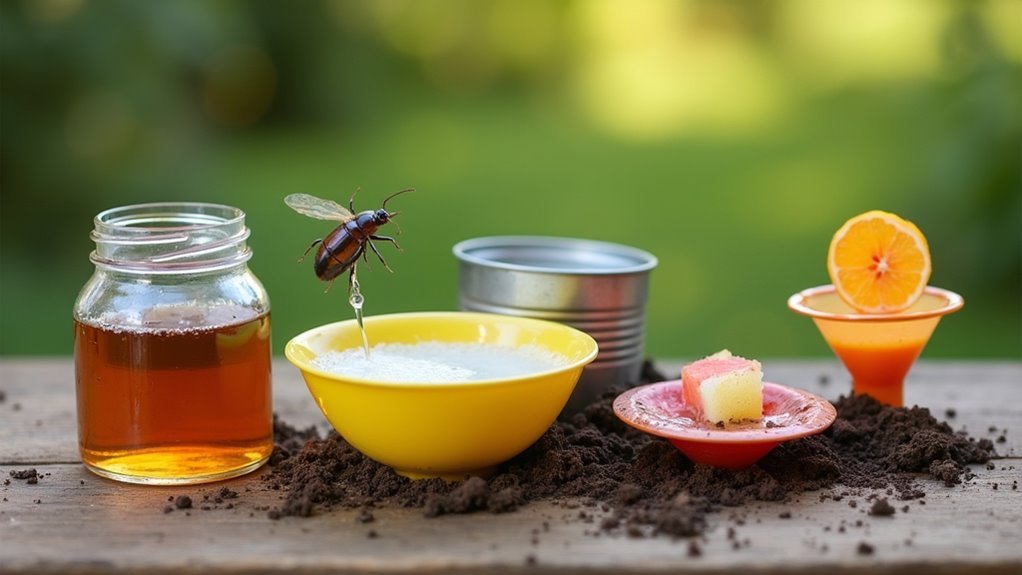You can trap beetles effectively using five simple household methods. Create sugar water containers at ground level for ground beetles, bury beer-filled jars flush with soil for slugs and garden beetles, or set up fermenting fruit bait stations using milk jugs with overripe bananas. Make sticky traps by coating cardboard with petroleum jelly for flying species, and position UV lights over soapy water dishes to catch nocturnal beetles. These proven techniques offer complete pest control solutions.
Sugar Water Container Trap for Ground Beetles

When ground beetles invade your garden or outdoor spaces, you can create an effective sugar water container trap using simple household items.
Fill a shallow container with a mixture of sugar and water to attract these pests seeking food sources. Position your trap at ground level in areas where ground beetles commonly gather, such as gardens or under vegetation.
The sweet solution will lure beetles into the container, where they’ll drown in the liquid. This eco-friendly method helps control ground beetle populations without harmful chemicals.
This chemical-free trapping method effectively reduces ground beetle numbers while protecting your garden environment from toxic pesticide exposure.
You’ll need to monitor the trap regularly and replace the sugar water mixture as needed to maintain its effectiveness in attracting and eliminating these unwanted insects.
Beer Pitfall Trap for Slugs and Garden Beetles
Beer pitfall traps offer another simple yet effective approach for targeting slugs and garden beetles that plague your outdoor spaces.
This non-toxic household solution uses fermenting beer’s scent to attract pests, causing them to fall into the trap and drown.
To create your pitfall trap:
- Bury a jar so its rim sits level with soil surface
- Fill the container halfway with beer to lure slugs and beetles
- Position traps near damaged plants where pest activity is highest
You’ll need to check and refill your traps regularly, especially after rainfall, to maintain the beer’s attractant properties.
This environmentally friendly method effectively controls pest populations without introducing harmful chemicals into your garden, making it an ideal household solution for persistent slug and beetle problems.
Fermenting Fruit Bait Station for May and June Beetles

May and June beetles respond particularly well to sweet, fermenting aromas, making a fruit bait station an excellent targeted approach for these seasonal pests.
You’ll need a milk jug and overripe household materials like bananas or apples to create this effective trap. Cut large openings in the jug, then fill it with rotting fruit. Let the mixture ferment for several days to intensify the scent that’ll attract beetles.
Peg the container into soil or hang it from low branches to prevent tipping. Position your trap in sunny, warm areas where beetle activity’s highest.
Check weekly to remove captured beetles and refresh the fermenting fruit mixture. Monitor the location’s effectiveness and relocate as needed for ideal results.
Sticky Card Traps for Flying Beetle Species
While ground-dwelling beetles require different approaches, flying beetle species demand traps that intercept them mid-flight, making sticky card traps your most effective aerial capture method.
These homemade sticky traps provide excellent pest control by utilizing adhesive surfaces that attract insects when they land.
Create your sticky card trap using cardboard coated with petroleum jelly or commercial adhesive. This simple design effectively captures various beetle species attempting to navigate your space.
- Strategic placement: Position traps near plants or light sources where flying insects commonly gather
- Color selection: Use yellow or white cards for maximum visual appeal to target beetle species
- Maintenance routine: Regularly check and replace traps when debris accumulates, reducing adhesive effectiveness
Consistent monitoring guarantees your traps maintain peak performance throughout beetle season.
Light-Based Night Trap for Nocturnal Beetles

Since nocturnal beetles navigate using natural light sources like the moon and stars, you can exploit this behavior by creating light-based traps that draw them away from your plants and into capture devices.
Position a UV light bulb over a shallow dish filled with soapy water. The trap works by attracting nocturnal beetles to bright light sources during their active hours. To enhance attraction, place traps in dark areas where the light contrast is greatest.
| Component | Purpose | Enhancement |
|---|---|---|
| UV Light Bulb | Attracts beetles | Use higher wattage |
| Shallow Dish | Contains soapy water | Add funnel for better capture |
| Soapy Water | Traps beetles | Change regularly |
| Dark Location | Increases contrast | Position away from competing lights |
| Bait Addition | Boosts attraction | Use fermenting fruit |
Regular monitoring and maintenance guarantee peak performance, requiring water changes and prompt beetle disposal.
Frequently Asked Questions
How to Make Homemade Beetle Traps?
You’ll need yellow plastic cups with Tanglefoot glue for sticky traps. Add clove oil-soaked cotton balls inside. For pitfall traps, bury containers flush with ground, fill with beer or sugar water as bait.
What Do Beetles Hate Most?
You’ll find beetles hate strong essential oil scents like peppermint, clove, and eucalyptus most. They also can’t stand diatomaceous earth, which damages their exoskeletons, and they’ll avoid overly dry environments completely.
How to Make a Homemade Bug Catcher?
You can create effective homemade bug catchers using common household items. Mix apple cider vinegar with dish soap for flies, or coat cardboard with petroleum jelly for roaches and beetles.
What Is the Best Bait for Beetles?
You’ll find sweet baits like ripe fruits, honey, or sugar solutions work best for most beetles. Fermenting materials such as overripe fruit or beer effectively mimic decaying matter that naturally attracts them.
In Summary
You’ve now got five proven beetle trap methods using items you likely already have at home. Whether you’re dealing with ground beetles, garden pests, or flying species, these DIY solutions will help you tackle your beetle problem without expensive store-bought traps. Remember to check your traps regularly and replace baits as needed. With consistent use, you’ll see a noticeable reduction in beetle activity around your property within just a few days.





Leave a Reply